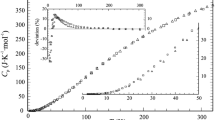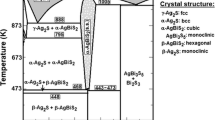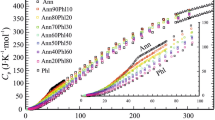Abstract
Six members of the annite–siderophyllite join were synthesized in a three step process – crystallization of biotite from gels, decomposition of the fine-grained biotite under oxidizing conditions and resynthesis of Fe-Al biotite with planned compositions from these products – producing biotite crystals with thicknesses of up to 10 μm. The biotite was characterized by microprobe, electron microscopy and X-ray diffraction. Heat capacities of these biotites were measured with a DSC (differential scanning calorimeter) over the temperature range 143 to 623 K. Using a least-squares technique, the data were fitted to a cp-polynomial, c p =k 0+k 1 T −0.5+ k 2 T −2+k 3 T −3. In the temperature range 143 to 250 K, heat capacities of the different annite–siderophyllite members decrease linearly with increasing Al content. At higher temperatures, however, the cp-polynomial of biotites with intermediate composition (except Ann79Sid21) exhibit a steeper slope than those of other biotites. This produces positive excess heat capacities in the annite–siderophyllite join at higher temperatures. The activity-composition data of the same binary derived from phase equilibrium experiments (Benisek et al. 1996) and the data of this study suggest two compositional regions along this join, with different extent of deviation from ideality. One at X Sid < 0.3, characterized by a small deviation, one at X Sid > 0.3 showing a higher nonideality, resulting in a discontinuity visible at this composition. Powder IR-spectra of these solid solutions were measured with a FTIR-spectrometer and used to calculate heat capacities according to the vibrational model of Kieffer (1979). The comparison of the vibrational function with the cp-polynomials shows that the vibrational function reproduces well the DSC-data of the siderophyllite-poor and -rich members, but deviates for intermediate compositions, where the excess heats of mixing occur. With increasing Tschermak vector, the tetrahedral rotation angle α increases from 0 to 13° for annite to siderophyllite, respectively. At the composition of the discontinuity, this rotation angle α reaches a value of ∼8∘. The processing of ∼300 chemical data of natural biotites indicates that over 90% of them have a tetrahedral rotation angle that lies between 7 and 9°. It would appear that biotites with these structural characteristics are most stable.
Similar content being viewed by others
Author information
Authors and Affiliations
Additional information
Received: 27 August 1998 / Accepted: 10 November 1998
Electronic Supplementary Material
Rights and permissions
About this article
Cite this article
Benisek, A., Dachs, E. & Cemic, L. Heat capacities of Tschermak substituted Fe-biotite. Contrib Mineral Petrol 135, 53–61 (1999). https://doi.org/10.1007/s004100050497
Published:
Issue Date:
DOI: https://doi.org/10.1007/s004100050497




